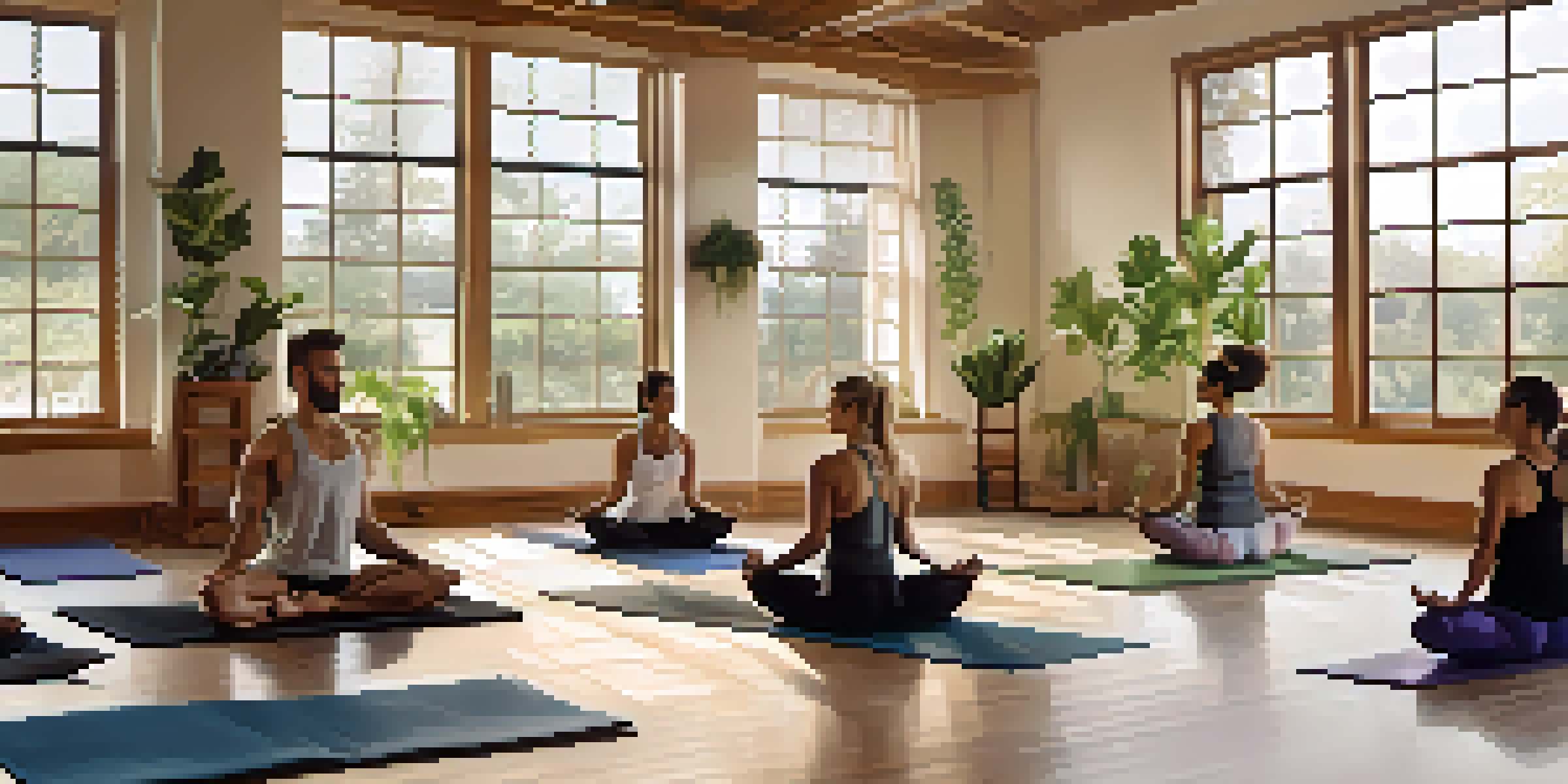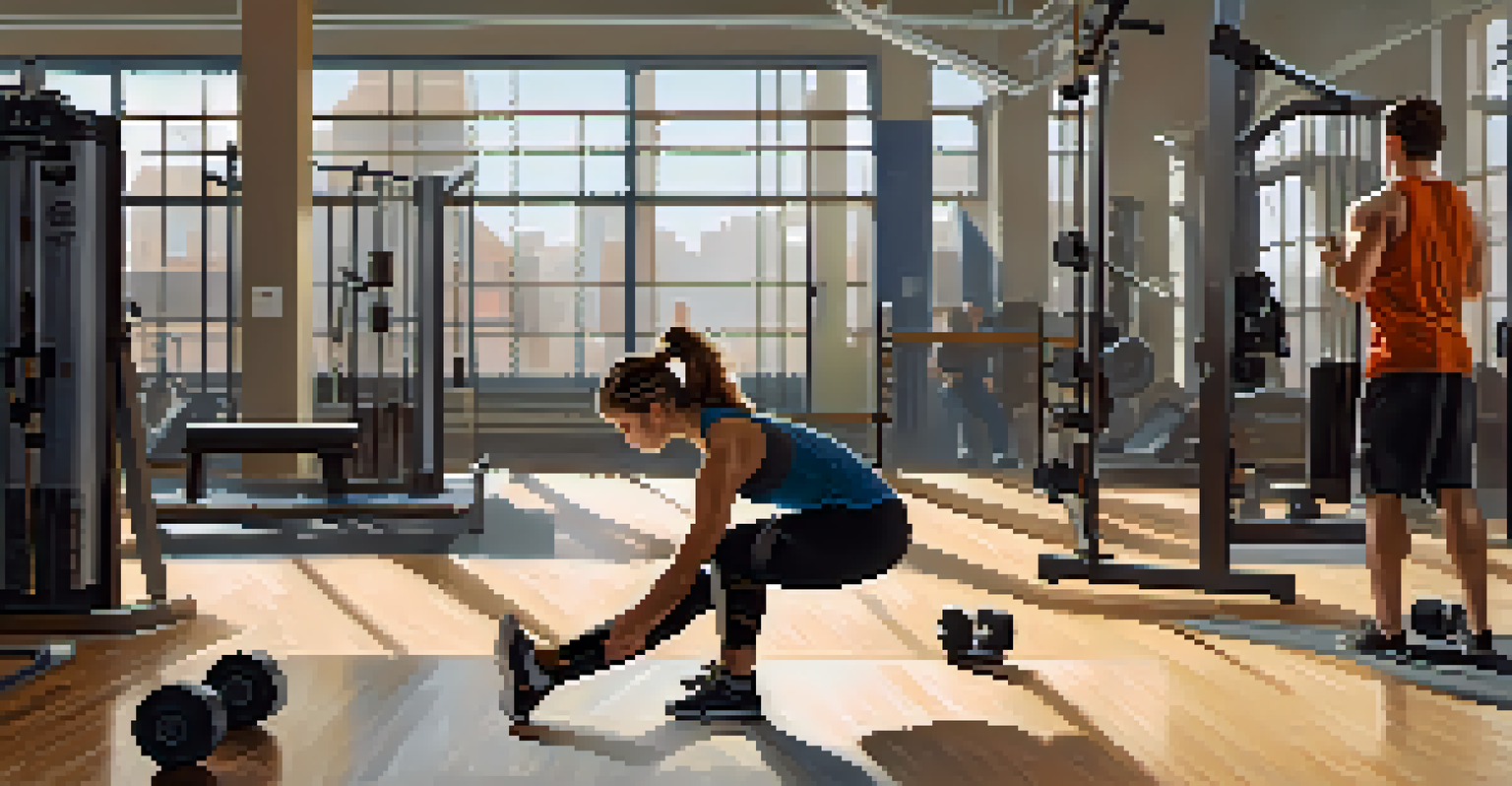Flexibility Training Techniques for Bodybuilding Success

Understanding Flexibility in Bodybuilding
Flexibility is often overlooked in bodybuilding, yet it plays a crucial role in overall performance. Simply put, flexibility refers to the range of motion in your joints and muscles, which can significantly affect your workout efficiency. When your muscles are flexible, you can lift more weight and perform exercises with better form, reducing the risk of injury.
Flexibility is the key to stability.
Many bodybuilders tend to focus solely on strength training, but neglecting flexibility can lead to stiff muscles and limited movement. Imagine trying to drive a car with the emergency brake on; it’s not going to perform at its best. Similarly, tight muscles can hinder your lifting potential, making flexibility training an essential component of any bodybuilding routine.
Incorporating flexibility exercises not only enhances your lifting ability but also aids in muscle recovery. The more flexible your muscles are, the less likely you are to experience soreness after a workout. This means you can get back to training sooner and continue to make progress toward your goals.
Dynamic Stretching: A Pre-Workout Essential
Dynamic stretching involves performing controlled movements that gently take your muscles and joints through their range of motion. It's an effective way to warm up before a workout, prepping your body for the physical demands ahead. For bodybuilders, incorporating dynamic stretches before lifting can enhance performance and prevent injuries.

For example, leg swings, arm circles, and torso twists are excellent dynamic stretches that can get your blood flowing and improve your flexibility. Think of dynamic stretching as revving up your engine before hitting the road—it gets everything ready for action. By adding dynamic movements to your routine, you’ll feel more agile and capable during your training sessions.
Flexibility Boosts Performance
Improving flexibility enhances lifting efficiency and reduces injury risk, making it essential for bodybuilders.
Additionally, dynamic stretching can help increase your heart rate and activate your muscles, making it a perfect companion to your warm-up. This not only prepares your body but also mentally gears you up for the workout ahead. As a result, you'll be more focused and ready to tackle those heavy lifts.
Static Stretching: The Post-Workout Recovery Tool
Static stretching involves holding a stretch for a prolonged period, usually around 15 to 60 seconds, and is best performed after your workout. This type of stretching helps cool down your muscles and improve overall flexibility. For bodybuilders, including static stretches in your post-workout routine can aid in muscle recovery and prevent stiffness.
The body achieves what the mind believes.
For instance, after an intense leg day, performing static stretches like the hamstring stretch or quadriceps stretch can help alleviate tightness. Picture your muscles as rubber bands: if they’re always stretched and never given a chance to relax, they can become damaged. Static stretching allows your muscles to recover and reset, ultimately enhancing your flexibility.
Moreover, static stretching can also promote relaxation and reduce post-workout soreness. By taking the time to stretch, you're signaling to your body that it's time to unwind, which can help you feel better overall. This is a simple yet effective way to ensure that you’re primed for your next training session.
Foam Rolling for Muscle Recovery and Flexibility
Foam rolling, or self-myofascial release, is a technique that involves using a foam roller to apply pressure to tight muscles. This practice can significantly enhance flexibility by breaking up muscle knots and improving blood flow. For bodybuilders, incorporating foam rolling into your routine can be a game-changer for recovery and flexibility.
Imagine your muscles as a dough that needs to be kneaded—foam rolling helps in smoothing out any lumps or tight areas. By rolling out your muscles before and after workouts, you can help reduce soreness and improve your overall mobility. This means you’ll not only feel better but also perform better during your lifts.
Dynamic Stretching Preps You
Incorporating dynamic stretching before workouts primes your muscles and joints, enhancing performance and focus.
Additionally, foam rolling can increase your range of motion, making it easier to execute exercises correctly. Over time, consistent use of a foam roller can lead to improved flexibility and reduced risk of injury. It’s a simple tool that can have a significant impact on your bodybuilding success.
Yoga: A Holistic Approach to Flexibility
Yoga is often associated with flexibility, and for good reason. Practicing yoga can significantly improve your flexibility while also enhancing your strength and balance. For bodybuilders, integrating yoga into your training routine can provide a comprehensive approach to physical fitness and overall well-being.
Through various poses and stretches, yoga encourages deeper muscle engagement and encourages relaxation. Consider it a way to tap into your body’s potential; the more you practice, the more you’ll discover your limits and how to push past them. This can lead to improved performance in the gym and a greater understanding of your body’s needs.
Moreover, yoga can also help with mental focus and stress relief, which are essential for any bodybuilder looking to improve their performance. By fostering a mind-body connection, you’ll be better equipped to handle the challenges of intense training. Incorporating yoga can truly elevate your bodybuilding journey.
Incorporating Flexibility Training into Your Routine
To reap the benefits of flexibility training, it’s essential to incorporate it into your regular workout routine. This doesn’t mean cutting down on your strength training; rather, it’s about finding a balance that works for you. By dedicating even just a few minutes each session to flexibility exercises, you can make a significant impact on your overall performance.
Consider scheduling specific days for flexibility training, or simply add it to your warm-up and cool-down routines. For instance, you might start your workouts with dynamic stretches and finish with static stretching or foam rolling. This way, you’re constantly working on your flexibility without sacrificing your strength goals.
Static Stretching Aids Recovery
Static stretching post-workout promotes muscle recovery and relaxation, ensuring you're ready for your next session.
Additionally, tracking your progress can help you stay motivated. Keep a record of your flexibility improvements and celebrate small victories along the way. Over time, you’ll notice that these efforts will pay off in the form of better lifts and reduced muscle soreness.
The Benefits of Flexibility for Bodybuilding Gains
The benefits of flexibility training extend far beyond just improved range of motion. Enhanced flexibility can lead to better muscle engagement during workouts, allowing you to maximize your strength training efforts. This means more effective lifts and, ultimately, greater muscle gains over time.
Moreover, improved flexibility can decrease your risk of injury, which is crucial for any bodybuilder. When your muscles are flexible, they can better withstand the demands of heavy lifting. Picture your muscles as elastic bands; when they’re too tight, they’re more likely to snap. Flexibility helps maintain the integrity of your muscles, ensuring you can keep pushing yourself safely.

Lastly, incorporating flexibility training into your regimen can enhance your overall athletic performance. Whether it’s through improved balance, coordination, or recovery, flexibility plays a vital role in helping you achieve your bodybuilding goals. By prioritizing flexibility, you’re setting yourself up for long-term success in your fitness journey.